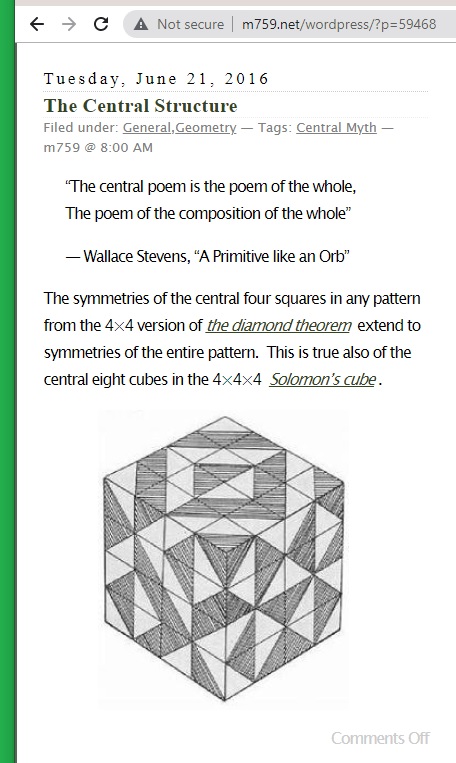
Thursday, August 8, 2024
Wednesday, August 7, 2024
In Other News . . .
Friday, September 3, 2021
Accounting for Taste

Risin' Up to the Challenge of Her Rival —
Art School Confidential —

Some context: The Power of the Center in this journal.
Friday, July 30, 2021
Central Objects
Friday, July 23, 2021
Art Direction
Cover illustration:
Spies returning from the land of
Canaan with a cluster of grapes.
Colored woodcut from
Biblia Sacra Germanica ,
Nuremberg, Anton Koberger, 1483.
Victoria and Albert Museum, London.


Friday, November 13, 2020
Sunday, July 21, 2019
Space Speaks, Time Listens
Saturday, March 23, 2019
Plan 9 Manifesto
"Arnheim was a particularly important source
for Norway's principal architectural theorist,
Christian Norberg-Schulz."
— Andrew Peter Steen, University of Queensland
doctoral thesis, 2015
See
- "Field of Manifestation,"
- "A Study in Art Education," and
-
"The Concept of Phenomenology in Architecture as Developed
by the Norwegian Theorist Christian Norberg-Schulz"
"Nine is a very powerful Nordic number."
— Katherine Neville, The Magic Circle
Thursday, May 18, 2017
Marquee Moon continues
Exit stage right, enter stage center, exit stage left —

A search for "Darkness Doubled" in this journal yields a link
to a post on "endgame art" which leads in turn to a post with
the following quotation —
"It is proposed that the two structures of grid and target
are the symbolic vehicles par excellence . . . ."
— Review of Rudolf Arnheim's The Power of the Center:
A Study of Composition in the Visual Arts (U. of Calif. Press, 1982).
Review by David A. Pariser, Studies in Art Education , Vol. 24, No. 3
(1983), pp. 210-213.
"Darkness Doubled" is a phrase from a song titled "Marquee Moon."
Sunday, April 3, 2016
Just Desserts:
Thursday, September 10, 2015
Grapevine
"Joseph Traub: I was born in Karlsruhe, Germany in 1932.
As you know, Hitler became chancellor in 1933. Traube is
the German word for grape, and since my family lived in the
grape-growing region of Baden for generations, I assume
that's how my name originated."
Related material: The Power of the Center .
Friday, July 24, 2015
Field of Manifestation
This post was suggested by a book title in
the previous post: "Pieces of the Action."
A group action is a mathematical concept.
Related meditation:
"The number 9, that is to say, relates traditionally
to the Great Goddess of Many Names (Devi,
Inanna, Ishtar, Astarte, Artemis, Venus, etc.)
as matrix of the cosmic process, whether in the
macrocosm or in a microcosmic field of manifestation."
— Joseph Campbell,
The Inner Reaches of Outer Space
Examples:
Monday, July 6, 2015
In Memoriam: Weintraub*
* For the title, see Weintraube in
a German-English dictionary.
This word was suggested by an
obituary in today's online Variety .
Wednesday, April 15, 2015
Birthdays
Today is the birthday of artist Leonardo da Vinci (b. 1452)
and of mathematician Leonhard Euler (b. 1707).
For both, a link.
Sunday, May 4, 2014
Geometry for Scarlett
Scarlett Johansson stars in a new film, "Lucy," due to be
released on August 8, directed by Luc Besson, auteur of
The Fifth Element (1997). In other pop culture…
"There have long been rumors of a mythical Ninth Element
that grants ultimate power to the Wizard who masters it.
The Order of Magick says there is no such thing. But…."
— Website of Magicka: The Ninth Element Novel
See also, in this journal, Holy Field as well as Power of the Center.
Monday, November 5, 2012
Sitting Specially
Some webpages at finitegeometry.org discuss
group actions on Sylvester’s duads and synthemes.
Those pages are based on the square model of
PG(3,2) described in the 1980’s by Steven H. Cullinane.
A rival tetrahedral model of PG(3,2) was described
in the 1990’s by Burkard Polster.
Polster’s tetrahedral model appears, notably, in
a Mathematics Magazine article from April 2009—
Click for a pdf of the article.
Related material:
“The Religion of Cubism” (May 9, 2003) and “Art and Lies”
(Nov. 16, 2008).
This post was suggested by following the link in yesterday’s
Sunday School post to High White Noon, and the link from
there to A Study in Art Education, which mentions the date of
Rudolf Arnheim‘s death, June 9, 2007. This journal
on that date—

The Fink-Guy article was announced in a Mathematical
Association of America newsletter dated April 15, 2009.
Those who prefer narrative to mathematics may consult
a Log24 post from a few days earlier, “Where Entertainment is God”
(April 12, 2009), and, for some backstory, The Judas Seat
(February 16, 2007).
Wednesday, January 5, 2011
Riff Design
"Leave a space." — Tom Stoppard, in a play about philosophers

The word "riff" at top in the Times obits is from an ad for Google's Chrome browser.
The white space is artificial, made by deleting last year's dead.

Monday, September 27, 2010
Friday, December 11, 2009
Central Ideas
David Brooks today on the historical background of Hanukkah:
"The Greeks had one central idea: their aspirations to create an advanced universal culture. And the Jews had their own central idea: the idea of one true God. The reformers wanted to merge these two ideas."
Related material:
Identity and the rest of March 2008
Saturday, January 10, 2009
Saturday January 10, 2009
Introduction
For details of the story,
click on the images.
Chapter I:
Chapter II:
Chapter III:
and the following quotation:
"There is no landing fee in Avalon,
or anywhere else in Catalina."
Wednesday, July 2, 2008
Wednesday July 2, 2008
“The serpent’s eyes shine
As he wraps around the vine”

Related material:

Spies returning from the land of
Canaan with a cluster of grapes.
Colored woodcut from
Biblia Sacra Germanica,
Nuremberg, Anton Koberger, 1483.
Victoria and Albert Museum, London.
Saturday, June 30, 2007
Saturday June 30, 2007
November 2004–

Controversial "Desperate Housewives"… ranks No. 5 among all prime-time shows for ages 12-17. ("Monday Night Football" is No. 18.) This may explain in part why its current advertisers include products like Fisher-Price toys, the DVD of "Elf" and the forthcoming Tim Allen holiday vehicle, "Christmas With the Kranks." Those who cherish the First Amendment can only hope that the Traditional Values Coalition, OneMillionMoms.com, OneMillionDads.com and all the rest send every e-mail they can to the F.C.C. demanding punitive action against the stations that broadcast "Desperate Housewives." A "moral values" crusade that stands between a TV show this popular and its audience will quickly learn the limits of its power in a country where entertainment is god. — "The Great Indecency Hoax," a New York Times column by Frank Rich quoted in Log24 on Nov. 26, 2004 |
The entertainment continues. A rabbi's obituary in today's New York Times (see previous entry) served as ad-bait for "Joshua," a Fox Searchlight film opening July 6.
A search for a less sacrilegious memorial to the rabbi yields the following:

The "Project MUSE" link above
works only at
subscribing libraries.
It seems that here, too,
the rabbi is being
used as bait.
For a perhaps preferable
reference to bait, in the
context of St. Peter as
a "fisher of men," see
the Christian "mandorla"
or "vesica piscis,"
a figure hidden within
the geometry of Rome's
St. Peter's Square–
which, despite its name,
is an oval:

For the geometric
construction of the
Roman oval, see
"ovato tondo" in
Rudolf Arnheim's
The Power of the Center.
For a less theoretical account
of the religious significance
of the mandorla, see
the 2001 film
The Center of the World.
Friday, June 15, 2007
Friday June 15, 2007
(continued from Dec. 11, 2006):
J. G. Ballard on "the architecture of death":
"… a huge system of German fortifications that included the Siegfried line, submarine pens and huge flak towers that threatened the surrounding land like lines of Teutonic knights. Almost all had survived the war and seemed to be waiting for the next one, left behind by a race of warrior scientists obsessed with geometry and death."
— The Guardian, March 20, 2006
From the previous entry, which provided a lesson in geometry related, if only by synchronicity, to the death of Jewish art theorist Rudolf Arnheim:
"We are going to keep doing this until we get it right."
Here is a lesson related, again by synchronicity, to the death of a Christian art scholar of "uncommon erudition, wit, and grace"– Robert R. Wark of the Huntington Library. Wark died on June 8, a date I think of as the feast day of St. Gerard Manley Hopkins, a Jesuit priest-poet of the nineteenth century.
From a Log24 entry on the date of Wark's death–
Samuel Pepys on a musical performance (Diary, Feb. 27, 1668):
"When the Angel comes down"
"When the Angel Comes Down, and the Soul Departs," a webpage on dance in Bali:
"Dance is also a devotion to the Supreme Being."
"I went to Bali to a remote village by a volcanic mountain…."
The above three quotations were intended to supply some background for a link to an entry on Taymor, on what Taymor has called "skewed mirrors," and on a related mathematical concept named, using a term Hopkins coined, "inscapes."
They might form part of an introductory class in mathematics and art given, like the class of the previous entry, in Purgatory.
Wark, who is now, one imagines, in Paradise, needs no such class. He nevertheless might enjoy listening in.
A guest teacher in
the purgatorial class
on mathematics
and art:


"Is it safe?"
Friday June 15, 2007
Art Education
Rudolf Arnheim, a student of Gestalt psychology (which, an obituary notes, emphasizes "the perception of forms as organized wholes") was the first Professor of the Psychology of Art at Harvard. He died at 102 on Saturday, June 9, 2007.
The conclusion of yesterday's New York Times obituary of Arnheim:
"… in The New York Times Book Review in 1986, Celia McGee called Professor Arnheim 'the best kind of romantic,' adding, 'His wisdom, his patient explanations and lyrical enthusiasm are those of a teacher.'"
A related quotation:
"And you are teaching them a thing or two about yourself. They are learning that you are the living embodiment of two timeless characterizations of a teacher: 'I say what I mean, and I mean what I say' and 'We are going to keep doing this until we get it right.'"
Here, yet again, is an illustration that has often appeared in Log24– notably, on the date of Arnheim's death:

Related quotations:
"We have had a gutful of fast art and fast food. What we need more of is slow art: art that holds time as a vase holds water: art that grows out of modes of perception and whose skill and doggedness make you think and feel; art that isn't merely sensational, that doesn't get its message across in 10 seconds, that isn't falsely iconic, that hooks onto something deep-running in our natures. In a word, art that is the very opposite of mass media. For no spiritually authentic art can beat mass media at their own game."
— Robert Hughes, speech of June 2, 2004
"Whether the 3×3 square grid is fast art or slow art, truly or falsely iconic, perhaps depends upon the eye of the beholder."
If the beholder is Rudolf Arnheim, whom we may now suppose to be viewing the above figure in the afterlife, the 3×3 square is apparently slow art. Consider the following review of his 1982 book The Power of the Center:
"Arnheim deals with the significance of two kinds of visual organization, the concentric arrangement (as exemplified in a bull's-eye target) and the grid (as exemplified in a Cartesian coordinate system)….
It is proposed that the two structures of grid and target are the symbolic vehicles par excellence for two metaphysical/psychological stances. The concentric configuration is the visual/structural equivalent of an egocentric view of the world. The self is the center, and all distances exist in relation to the focal spectator. The concentric arrangement is a hermetic, impregnable pattern suited to conveying the idea of unity and other-worldly completeness. By contrast, the grid structure has no clear center, and suggests an infinite, featureless extension…. Taking these two ideal types of structural scaffold and their symbolic potential (cosmic, egocentric vs. terrestrial, uncentered) as given, Arnheim reveals how their underlying presence organizes works of art."
— Review of Rudolf Arnheim's The Power of the Center: A Study of Composition in the Visual Arts (Univ. of Calif. Press, 1982). Review by David A. Pariser, Studies in Art Education, Vol. 24, No. 3 (1983), pp. 210-213
Arnheim himself says in this book (pp. viii-ix) that "With all its virtues, the framework of verticals and horizontals has one grave defect. It has no center, and therefore it has no way of defining any particular location. Taken by itself, it is an endless expanse in which no one place can be distinguished from the next. This renders it incomplete for any mathematical, scientific, and artistic purpose. For his geometrical analysis, Descartes had to impose a center, the point where a pair of coordinates [sic] crossed. In doing so he borrowed from the other spatial system, the centric and cosmic one."
Students of art theory should, having read the above passages, discuss in what way the 3×3 square embodies both "ideal types of structural scaffold and their symbolic potential."
We may imagine such a discussion in an afterlife art class– in, perhaps, Purgatory rather than Heaven– that now includes Arnheim as well as Ernst Gombrich and Kirk Varnedoe.
Such a class would be one prerequisite for a more advanced course– Finite geometry of the square and cube.
Thursday, June 14, 2007
Thursday June 14, 2007
Epiphany: A link in the Log24 entries for Epiphany 2007 leads to Damnation Morning, which in turn leads to Why Me?, a discussion of the mythology of Spiders vs. Snakes devised by Fritz Leiber. Spiders represent the conscious mind, snakes the unconscious.
On Hexagram 18: "The Chinese character ku represents a bowl in whose contents worms are breeding. This means decay." —Wilhelm's commentary
This brings us back to the previous entry with its mention of the date of Rudolf Arnheim's death: Saturday, June 9. In Log24 on that date there was a link, in honor of Aaron Sorkin's birthday, to a short story by Leonard Michaels. That link was suggested, in part, by a review in the Sunday New York Times Book Review (available online earlier, on Friday). Here is a quote from that review related to the Hexagram 18 worm bowl:
"… what grabbed attention for his early collections was Michaels's gruesome, swaggering depiction of the sexual rampage that was the swinging '60s in New York– 'the worm bucket,' as Michaels described an orgy."
Related material for meditation on this, the anniversary (according to Encyclopaedia Britannica) of the birth of author Jerzy Kosinski— his novel The Hermit of 69th Street.
Kosinski was not unfamiliar with Michaels's worm bucket. For related information, see Hermit (or at least a review).
In Leiber's stories the symbol of the Snakes is similar to the famed Yin-Yang symbol, also known as the T'ai-chi tu. For an analysis of this symbol by Arnheim, see the previous entry. See also "Sunday in the Park with Death" (Log24, Oct. 26, 2003):
Thursday June 14, 2007
In memory of
Rudolf Arnheim,
who died on
Saturday, June 9
From the Wikipedia article on Gestalt psychology prior to its modification on May 31, 2007:
“Emergence, reification, multistability, and invariance are not separable modules to be modeled individually, but they are different aspects of a single unified dynamic mechanism.
For a mathematical example of such a mechanism using the cubes of psychologists’ block design tests, see Block Designs in Art and Mathematics and The Kaleidoscope Puzzle.”
The second paragraph of the above passage refers to my own work.
Some Gestalt-related work of Arnheim:

“Perceptual Analysis of a
Symbol of Interaction,”
pp. 222-244 in
Toward a Psychology of Art:
Collected Essays,
Univ. of Calif. Press, 1966
Time of this entry:
1:06:18 AM ET.





















